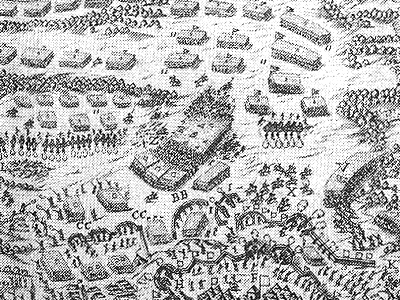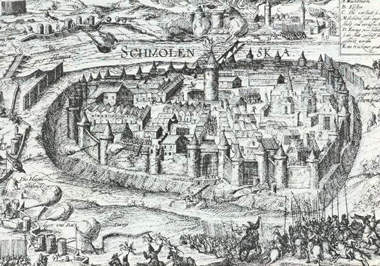
Army Composition
|
Early 17th Century Battle Tactics Against outnumbering masses of mobile cavalry, such as Tatars, the Poles used deep formations, with the wings deepest. They then purposefully entered the enemy's trap of encirclement and aimed at breaking straight through. The small numbers of infantry and artillery were used to prepare the way for the heavy cavalry with their firepower. Screens of wagons were used, though these had the drawback of hampering the cavalry's movement. One solution, used by Koniecpolski at Martynow in 1624, was to place the wagons behind each wing, thereby protecting the flanks but leaving the cavalry free to manoeuvre.
Fighting Western European foes the
infantry's firepower was crucial to prepare the way for the cavalry,
although the outcome of a battle was decided by heavy cavalry charges.
Batory's reforms gave the Polish cavalry a high mobility and a highly
developed economy of strength. This was superbly illustrated at
the battle of Kircholm in 1605, where Polish forces succeeded in
surrounding and routing a three times larger Swedish force. The
victory owed its success to the mobility of the cavalry whose small
numbers occupied the Swedish centre and left, while on the right
they achieved numerical superiority and turned A strong reserve was an important component in most battles of this period, used only when the enemy had committed all his forces and then unleashed in a devastating charge. This reserve could consist of up to one third of the army. Since 1514, firepower played an important role in Polish military thought and the husars achieved success only where they collaborated closely with the small numbers of infantry and artillery. This collaboration was especially pronounced in the defence of field fortifications where the cavalry gave them an offensive capability. In the 1620's when the Poles met the massive firepower and skilful manoeuvring of Gustav Adolf's reorganised army, they had few immediate answers. Gustav avoided open battle, carefully shielding his army with field obstacles, and the Poles could not counter the Swedish firepower superiority. So they resorted to a campaign of harassment and attempts to catch the Swedes on the march. Deep incursions into enemy territory also played an important part in Polish warfare. They varied in size from a few hundred to a few thousand, and their depth reached up to a few thousand kilometres. They were often used against the Tatars, as well as the Swedes and Russians. Their objectives were to disrupt the enemy's supplies and preparations for war and to take away their initiative. They were also used to protect the main army while travelling in enemy territory. Primary scource: A republic of Nobles: Studies in Polish History to 1864, edited and translated by J.K. Fedorowicz - University of Western Ontario. Cambridge University Press (1982) |
|
![]()
 When
encountering the forces of the Ottoman Empire the Poles took a more
defensive posture, mainly due to the size and quality of the Turkish
forces. Though there were few fortifications in southern Poland,
the Turkish army's way was usually blocked by an entrenched Polish
army. The Poles employed deep defences by building separate field
works in front of the camp's defences, as at Chocim in 1621. These
field works could be defended and allowed the use of cavalry counter
attacks. They still, however, hampered the army's movement so whenever
possible, if the enemy's numbers were not overwhelmingly superior,
the whole army was led out into the open, such as at Cecora 1620.
The camp to the rear acted only as a refuge and did not affect the
course of the battle. A later improvement was to place independent
redoubts in front of the camp that gave direct support to the army.
A system of advance guns was also used and was linked solely by
firepower, Kamieniec Podolski, 1633.
When
encountering the forces of the Ottoman Empire the Poles took a more
defensive posture, mainly due to the size and quality of the Turkish
forces. Though there were few fortifications in southern Poland,
the Turkish army's way was usually blocked by an entrenched Polish
army. The Poles employed deep defences by building separate field
works in front of the camp's defences, as at Chocim in 1621. These
field works could be defended and allowed the use of cavalry counter
attacks. They still, however, hampered the army's movement so whenever
possible, if the enemy's numbers were not overwhelmingly superior,
the whole army was led out into the open, such as at Cecora 1620.
The camp to the rear acted only as a refuge and did not affect the
course of the battle. A later improvement was to place independent
redoubts in front of the camp that gave direct support to the army.
A system of advance guns was also used and was linked solely by
firepower, Kamieniec Podolski, 1633.  the flank.
the flank.  In
1633, Wladyslaw's new 'foreign' infantry were used to attack Muscovite
field fortifications at Smolensk, while continually digging in and
establishing new artillery positions in front of their previous
ones. Their attacks were followed by a wave of cavalry sent to destroy
any Muscovite counterattack. The new infantry had an offensive capability
and were directly used to open the way for the heavy cavalry. They
were still used to hit the enemy with their firepower as shown at
Kamieniec Podolski, 1634, when all the Turkish front attacks broke
on the infantry and artillery firepower.
In
1633, Wladyslaw's new 'foreign' infantry were used to attack Muscovite
field fortifications at Smolensk, while continually digging in and
establishing new artillery positions in front of their previous
ones. Their attacks were followed by a wave of cavalry sent to destroy
any Muscovite counterattack. The new infantry had an offensive capability
and were directly used to open the way for the heavy cavalry. They
were still used to hit the enemy with their firepower as shown at
Kamieniec Podolski, 1634, when all the Turkish front attacks broke
on the infantry and artillery firepower.